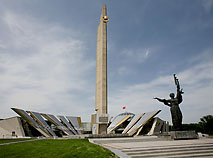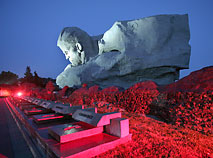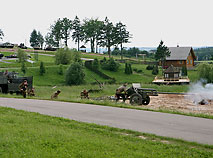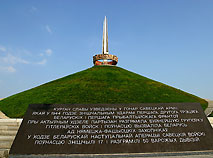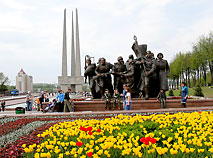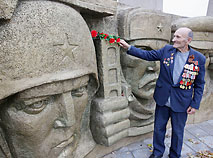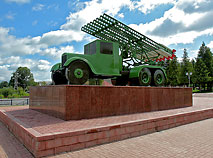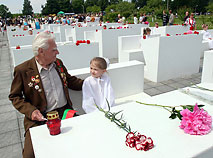Great Patriotic War monuments in Belarus
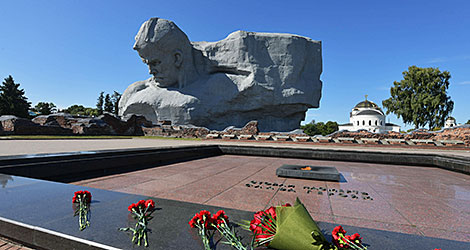
In various parts of Belarus, which lost every third citizen in 1941-1945, symbolical memorial complexes have been created and monuments have been erected to highlight events of the most tragic and devastating war that the much-suffered land has seen.
At present there are about 9,000 monuments and graves dating back to the Great Patriotic War in Belarus. They are part of military history tours but most importantly they represent sacred places where people come to honor the fallen and remember the value of peace…
Victory Monument in Minsk
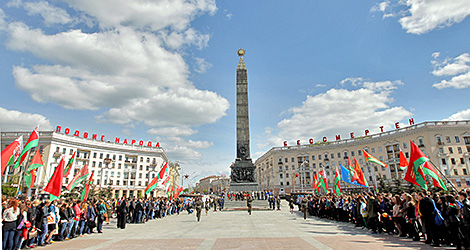
Victory Square, Minsk
The architectural and sculptural complex Minsk Hero City
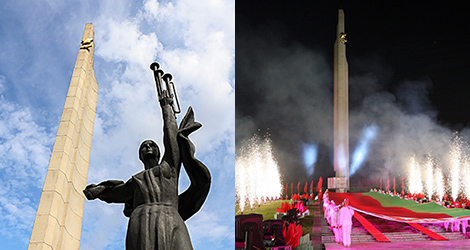
The stela Minsk Hero City was erected in 1985 in honor of the 40th anniversary of the Great Patriotic War. It is now part of the magnificent compound of the Great Patriotic War History Museum. In 1974 Minsk was honored with the title of hero city for the courage and bravery its residents demonstrated during the Nazi occupation that lasted for 1,100 days and nights. On top of the 45-meter obelisk is a Hero Star. At the bottom visitors can see an engraved text that describes the acquisition of the honorable title by the city. Standing with fanfares raised high, the symbolical figure of the Motherland is part of the compound. Nowadays majestic military parades and processions on the day of the key national holiday – Independence Day – take place near the stela Minsk Hero City.
Pobeditelei Avenue, Minsk
The state memorial complex Khatyn
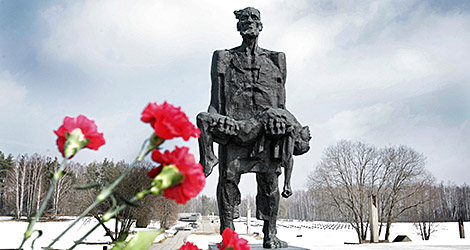
The Khatyn Memorial is a symbol of tragedy and unbelievable courage of the Belarusian people; it is a tribute to the memory of every third Belarusian killed in the Great Patriotic War… The Belarusian village of Khatyn is famous all over the world. Here on 22 March 1943 the Nazi brutally murdered 149 local residents, including the elderly and 75 children. The people were burnt alive in a locked barn. Those who tried to escape from the fire were shot dead. This impressive memorial was built in place of the village to commemorate the tragedy of Khatyn and hundreds of other villages destroyed together with its residents. More than 36 million people from around the world visited the place since the memorial was unveiled in 1969.
Logoisk District, Minsk Oblast
Dalva Memorial Complex
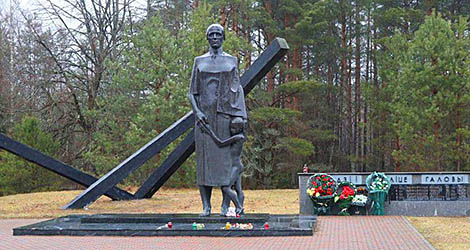
More than 5,000 Belarusian villages were raised to the ground during the Great Patriotic War. Among them is Dalva that shared the tragic fate of Khatyn. On the site where the village once stood a memorial complex was built. It consists of a memorial, a small museum and concrete sets of house frames. The memorial complex was the lifetime project of Nikolai Girilovich, a village resident who miraculously survived the incineration. The other residents – 44 people, including 29 children – were rounded up in one house and burnt alive. The barbarous punitive operation was carried out just ten days before the advance of the Red Army.
Logoisk District, Minsk Oblast
The memorial complex Glory Mound
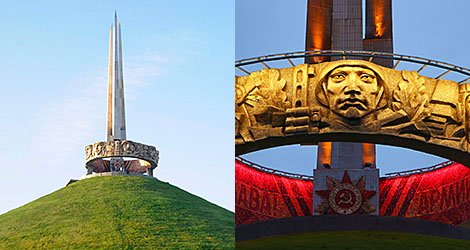
The Mound of Glory commemorates Belarus’ liberation from the Nazi invaders. Taking part in Operation Bagration, a codename for the Soviet 1944 Belorussian Strategic Offensive Operation and one of the biggest operations in the history of humankind, were four fronts led by outstanding military leaders Rokossovsky, Zakharov, Chernyakhovsky and Bagramyan, as well as sailors of the Dnieper river flotilla, French pilots from the Normandie-Niemen Regiment and, of course, Belarusian partisans. The Mound of Glory Memorial Complex is 70.6m high. On top of the hill (35m) that holds the soil brought from the hero cities are four bayonets symbolizing the brotherhood of fatherland defenders, and a glory ring depicting the faces of soldiers and partisans.
Smolevichi District, Minsk Oblast
The historical and cultural complex Stalin’s Line
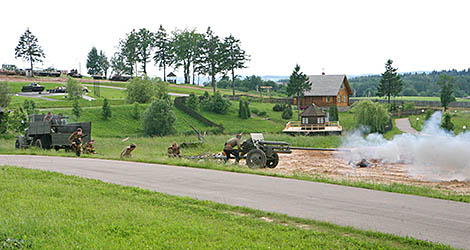
The fascinating open-air military museum is located in the Minsk fortified zone, which was part of the famous Stalin’s Line built in 1930 along the borders of the USSR stretching from Karelia in the north to the Black Sea coast in the south. The museum has authentic pillboxes from the times of the war. It also features all kinds of trenches and antitank ditches, shooting positions, bunkers for soldiers and trenches for guns. The museum has Belarus’ biggest exposition of military equipment, aviation and weapons of different years, starting from the times of the Great Patriotic War, a unique collection of gun turrets from the First World War...
Stalin’s Line is an interactive museum: Here you can see the reenactment of historical battles, fire a real weapon from the times of the Great Patriotic War (Mauser, Mosin rifle or Maksim machine-gun), drive a modern armored vehicle and legendary tanks, and taste soldier's porridge. The museum has the memorial "Maritime Glory of Belarus" that boasts a 300-year-old anchor of the times of Peter the Great and famous amphibious tank PT-76.
Minsk District
The memorial complex Brest Hero Fortress
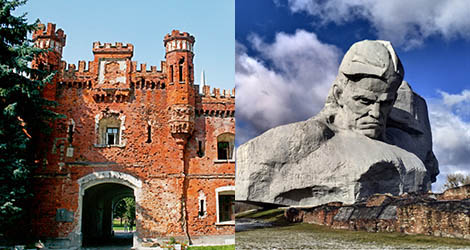
Belarus’ major citadel took the brunt of the fierce Nazi attacks at the very start of the Great Patriotic War. The fortress held off the German offensive for 28 days. A grandiose memorial complex was erected to commemorate the fortress defenders. In the center of the complex is the 33.5-meter high Courage Memorial depicting a warrior and a banner. The unique open-air architectural and sculptural ensemble tells a tragic story of the heroic defense of the fortress. Here you can see a 100-meter high Bayonet Obelisk – the symbol of the victory over the enemy, the Ceremony Square commemorating the fallen heroes, the Brest Fortress Defense Museum and one of the oldest stone buildings of the old Brest-Litovsk – While Palace.
St. Nicolas Church was built on the territory of the fortress in 1851-1876. This magnificent Byzantine-style basilica is one of the most beautiful churches in Central Europe. At the beginning of the war it became a major stronghold of the fortress defenders.
Brest
The memorial complex in honor of liberators of Pinsk
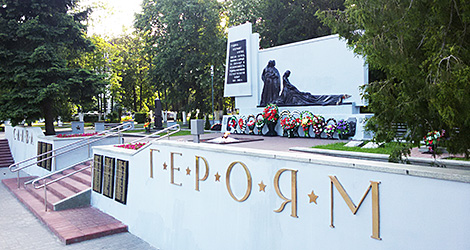
A communal grave is at the center of the memorial dedicated to the heroes, who liberated the city of Pinsk. Remains of 244 soldiers are in that grave. Close to it is a monument to the armored boat BK-92 and a symbolical sign erected in the place where the Dnieper flotilla landed. The famous reconstructed Molchanov’s Pillbox is nearby. In 1944 it was the command post of Major Georgy Molchanov, who commanded the 1323rd rifle regiment. It is the place where the first message about Pinsk’s liberation came from. The interior of the legendary command post has been recreated and now features plans of military operations, maps, a soldier memory journal. After reconstruction the memorial will get an open-air military hardware museum.
Pinsk, Brest Oblast
The memorial complex Buinichi Field
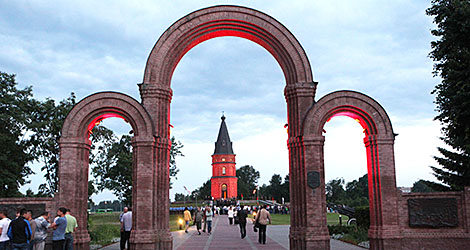
The memorial commemorates the soldiers who defended the city against the Nazis for 23 days in July 1941. The heroism of the soldiers is one of the brightest pages of the Great Patriotic War. Mogilev is often called "the Father of Stalingrad". The memorial has a red chapel featuring memorial tablets with the names of the killed defenders. There is also the Foucault pendulum, a symbol of imperishable memory, at the memorial. Four alleys radiate from the chapel, with one dedicated to the first chronicler of the Mogilev defense, author of the Alive and the Dead novel Konstantin Simonov. Nearby is an open-air exposition of military hardware.
Not far away from the chapel is the Lake of Tears, representing the suffering of all the mothers who lost their children during the war.
Mogilev
The memorial complex Dugout
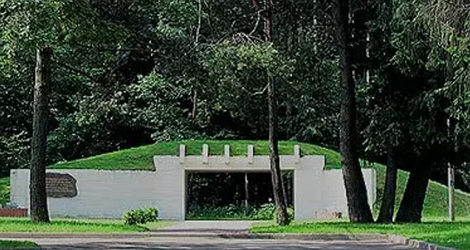
The huge partisan dugout made of concrete and a stela with a commemorative inscription were installed in the first kilometer of the Mogilev-Chausy motorway in 1982. It was the place of the Western Front command post in the early days of the Great Patriotic War. On 1 July 1941 the place saw the first conference on protecting the Dnieper River Line and creating underground resistance units behind enemy’s lines. The heroic defense of Mogilev began several days later. Soviet Union marshals K. Voroshilov and B. Shaposhnikov took part in the conference. Several days later the heroic defense of Mogilev began. The 172nd rifle division (General M. Romanov) and the 110th rifle division (Colonel V. Khlebtsev) of the 61st rifle corps of the 13th army, other Red Army units, who were moving from the west, and people’s militia, who rose up to protect the native city, kept the Nazi at bay there for 23 days and nights.
Mogilev District
In Memory of Burned Villages Complex, Mogilev Oblast
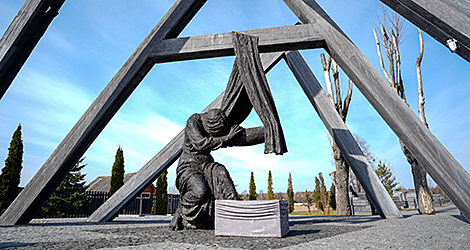
The memorial complex in the village of Borki, Kirovsk District, pays tribute to the memory of the villages burned down by the Nazis during the Great Patriotic War. There were hundreds of villages in Belarus who shared the tragic fate of Khatyn. The stories of many of them made part of the famous documentary book Out of the Fire by Belarusian writers Yanka Bryl, Ales Adamovich and Vladimir Kolesnik who recorded the stories of more than 300 eyewitnesses of those events... The bloody list includes the village of Borki which was burned down by the Nazis together with its residents on 15 June 1942. It made history as one of the biggest punitive operations of the war – a total of 2,000 people from Borki and neighboring villages were burnt. A wall of memory, six panels with the names of the destroyed villages, bells and a chapel in honor of the Icon of the Mother of God The Seeking of the Lost were built here decades later.
Village of Borki, Kirovsk District, Mogilev Oblast
Ludchitsy Height Memorial of Military Glory
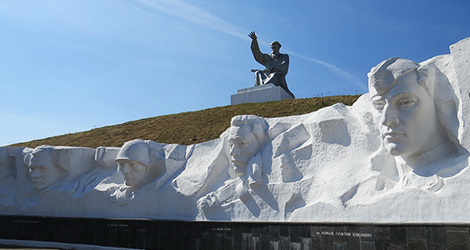
A symbolic figure of a guslar is overlooking a high mound. He sings his eternal song about courage and sacrifice of the fallen heroes. At the bottom of the mound is a stele featuring six bas-reliefs of Heroes of the Soviet Union: Vladimir Martynov, Sundutkali Iskaliyev, Gulyam Yakubov who died while storming the Ludchitsy Height in June 1944, as well as Ivan Borisevich, Petr Vinichenko and Galaktion Razmadze who took part in the liberation of Bykhov District. The commemoration symbol – Eternal Flame – is burning at the monument, while the names of the soldiers killed in the battle for the height are engraved in the memorial at the mound of military glory.
Bykhov District, Mogilev Oblast
Memorial in honor of the soldiers of the 1st Belarusian Front and partisans
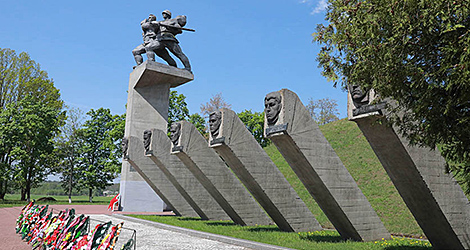
The memorial complex in Sychkovo is dedicated to the soldiers and partisans who in June 1944 took part in the decisive stage of the Bagration liberation operation. A 40,000-strong German army group Center was destroyed in the Bobruisk cauldron. In 1967, the locals immortalized the feat of the heroes-liberators in the Mound of Glory, with the capsules containing soil from 70 mass graves buried inside of it. The 18-meter pedestal is crowned with the sculpture of the two soldiers, the stelas with the statues of 6 heroes of the Soviet Union: Ivan Oryol, Nikolai Kolodko, Aleksandr Chernysh, Mikhail Seleznev, Ivan Maslovsky and Nikolai Izyumov. Later the memorial was completed with the Gate of Fame and 13 commemorative plaques in tribute to the heroes of the Soviet Union who died liberating the Mogilev land.
Bobruisk District, Mogilev Oblast
Victory Square Memorial Complex in Vitebsk
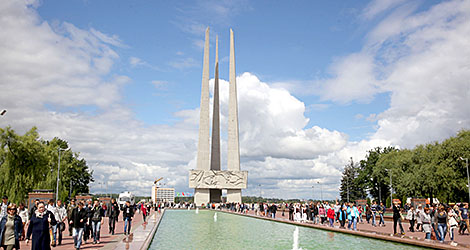
The memorial known as Three Bayonets commemorates Soviet soldiers and partisans from Vitebsk Oblast. It is located on the bank of the Dvina River at the very heart of the city. On the three 56-meter bayonets one can see a relief depicting Soldiers, Underground Fighters and Partisans. The Eternal Flame lit on the star-shaped podium throws light on the Glory to Heroes inscription engraved on the unifying internal ring of the monument. Apart from the main monument, the complex features two big pools with fountains, ten poles and sculptures depicting Soviet fighters and civilians. On the Pobeditelei Park you can walk along the Alley of Military Glory and visit an exposition of combat vehicles of the Great Patriotic War.
Vitebsk
Memorial complex For Our Soviet Motherland (Katyusha)
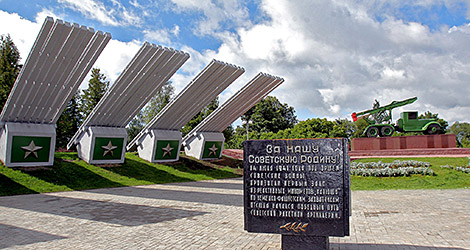
A large statue of the legendary weapon – combat rocket launcher BM-13 which the Soviet soldiers called Katyusha was installed on the banks of the Dnieper in Orsha. Its design and a firestorm effect remained a mystery for the Germans for years. It was in Orsha that on 14 July 1941 first Katyusha battery went in action: the experimental battery of seven machines under the command of Captain Flyorov bombarded the enemy’s trains at a railway station and positions at the river crossing. The memorial consists of 6 "mortar launchers" made of concrete. In the center of the pedestal there is an exact copy of Katyusha made in 1941. At the entrance to the complex there is a black cube with a commemorative inscription on the first use of the famous rocket launcher.
Mogilevskaya Street, Orsha
Condemnation of Fascism Memorial Complex
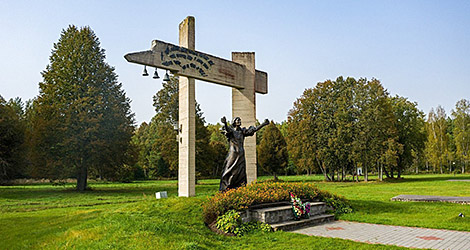
Condemnation of Fascism Memorial Complex is dedicated to the tragedy of Dokshitsy District which saw more than 20,000 people killed and 97 villages razed to the ground during the Great Patriotic War. One of them is Shunevka. It has its “grave” on the symbolic graveyard of 186 villages burnt with their residents. This graveyard was erected in the Khatyn Memorial Complex. The village of Shunevka and 66 of its residents had their last day on 22 May 1943: all adults were burned alive in a shed and defenseless children were thrown into the well to die. The memory of the innocent lives is immortalized in the monument featuring the frame of a well, inside of which there is a "broken" kite made of bronze with the engraved children's names. In the center of the memorial there is the Gate of Sorrow with the desperate mother lifting her hands to the sky. Over it there are three bells; one of them is broken to symbolize the eternal memory of the dead. On the ground where the houses once stood, there are 22 house foundations with the steps and "frozen flame" bearing the names of the owners...
Shunevka village, Dokshitsy District, Vitebsk Oblast
Breakthrough Memorial Complex
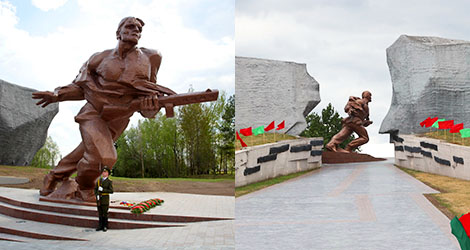
An impressive war memorial was created at the place of the legendary breakthrough of the Nazi blockade by the partisans of the Polotsk-Lepel zone, one of the biggest partisan zones in the occupied Belarus. The real partisan republic with its headquarters in Ushachi was set up in autumn 1942. In spring 1944 the Nazi Germany used 60,000 punishers, aviation, tanks and artillery against 17,000 partisans. On the tragic night of 4-5 May partisans destroyed the enemy and liberated 16,000 civilians… Hundreds of dead soldiers were buried in the mass grave named Breakthrough, with even more names perpetuated on its plaques. The memorial opens with a bronze map of defense. An arrow-shaped road goes past huge boulders pointing to the direction of the main attack. A fearless soldier "runs" on it with an automatic rifle in his hands. Nearby there are 16 oaks, a symbol of fortitude of 16 partisan brigades. The memorial complex also includes a partisans’ village, which is a series of dugouts featuring wartime utensils and an exposition of military equipment.
Paperino village, Ushachi District, Vitebsk Oblast
Mound of Glory Memorial Complex in Gomel
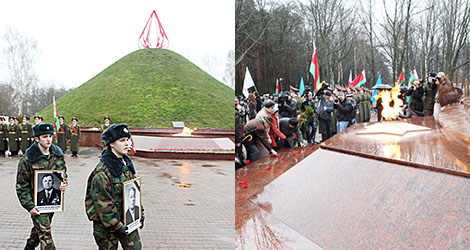
Gomel’s Mound of Glory was set up in 1967 to honor the feat of the soldiers and partisans who fell in the Great Patriotic War. At the foot of the memorial there are capsules with soil from more than 200 places of Belarus, Russia and Ukraine that witnessed the biggest war battles. Soil was also brought from the glorious hero cities such as Moscow, Kiev, Leningrad, Odessa and Belarus’ main citadel, Brest Fortress. In 2013 the Eternal Flame was opened at the Mound of Glory as part of a large-scale renovation project in the run-up to the 70th anniversary of the liberation of Gomel. The message for the future generations was opened in 2017 ahead of the 100th anniversary of the October Revolution. A new time capsule was laid to be unveiled 50 years later, in 2067.
Gomel
Ola Memorial Complex
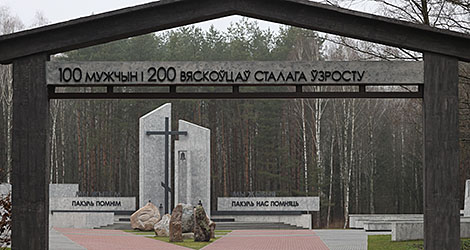
The impressive memorial was set up on the site of the village of the same name burned down by the Nazis during the Great Patriotic War. The opening of the memorial, a new symbol of remembrance and sorrow for all Belarusians, took place on 21 June 2020, the year of the 75th anniversary of the Great Victory and the day of the beginning of the war. The village of Ola was occupied by the Nazis at the end of July 1941. On the morning of 14 January 1944, a German punitive detachment together with a military unit of about 1,000 soldiers surrounded the village. People were driven into houses, which were then set on fire. Those who tried to escape were shot with machine guns and assault rifles, thrown into the fire alive. On that fateful day, 1,758 civilians were killed, more than half of them were children – 950 young lives. That's almost twelve Khatyns! After the war, the village of Ola never revived. In 1958, a sculpture of a kneeling soldier with a wreath was erected on the the place of the mass grave where civilians and Soviet soldiers (2,253 people) were buried. By the 75th anniversary of the Victory, the burial place turned into a large memorial complex "Ola". The symbolic place features three parts: the entrance group, the memorial zone and a connecting pedestrian route along the former village street. In the center of the memorial zone there stands a symbolic cross and a bell. Nearby is a bell tower in the form of a stylized village barn with as many bells as villages whose inhabitants were killed in this place.
Svetlogorsk District, Gomel Oblast
Bagration Operation Memorial Complex
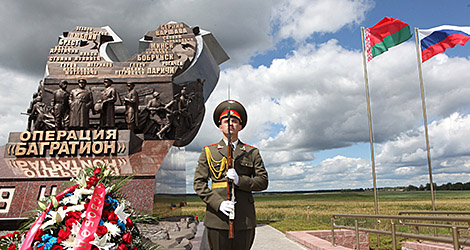
The world’s first memorial to commemorate one of the biggest military operations in the human history was unveiled in Svetlogorsk District to mark the 70th anniversary of Belarus’ liberation from the Nazis. The large-scale offensive that lasted for more than two months was launched near the village of Rakovichi, at the 71st kilometer of the Bobruisk-Mozyr highway, on 23 June 1944. In the result of the operation, named after commander, Hero of the Patriotic War of 1812 Piotr Bagration, the Red Army liberated Belarus, partially liberated the Baltic states and Poland, and almost completely destroyed the German Army Group Centre…The 7-meter bas-relief features the figures of four commanders who took part in the operation...
The memorial complex includes a blindage-like museum dedicated to the Bagration Operation, a chapel with an obituary and an exhibition of hardware and armaments.
Rakovichi village, Svetlogorsk District, Gomel Oblast
Battle of the Dnieper Memorial Complex
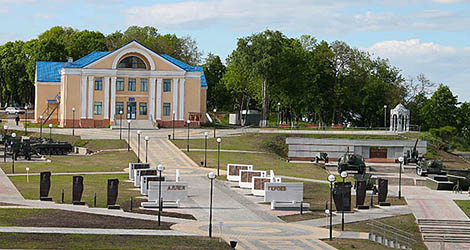
The war memorial in Loyev commemorates one of the biggest battles of the Great Patriotic War – the operation to cross the Dnieper in October 1943. An 18-meter obelisk, a reduced copy of the Victory Memorial in Minsk, was erected in the center of the town in 1966. Following the reconstruction for the 70th anniversary of the Great Victory the central square was transformed into a memorial ensemble. To each side of the Alley of Glory there is an open-air exposition entitled the Museum of the Battle of the Dnieper that displays the samples of the military hardware that took part in the battle. Hundreds of names were perpetuated on the memorial plaques. 323 soldiers were awarded the title of the Hero of the Soviet Union for incredible bravery in the battles for Loyev, a unique fact in the history of the Great Patriotic War.
Loyev, Gomel Oblast
Memory Memorial Complex
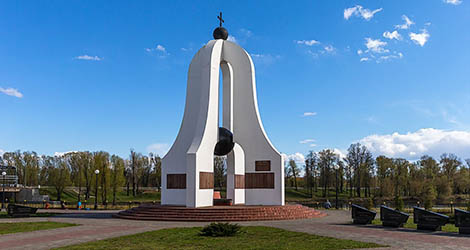
Dobrush whose residents joined the Red Army in their liberation march was freed from the Nazi troops on 10 October 1943. The Memory Memorial Complex was erected on the site of a mass grave on the bank of the Iput River in 2005. The memorial commemorates 700 fighters who died during the liberation of the town.
Dobrush, Gomel Oblast
War Memorial to the Soldiers of the Belarusian Border District
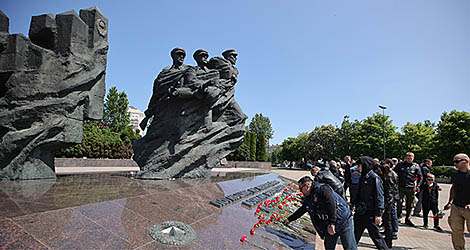
The memorial in Grodno downtown was unveiled in 2004 to commemorate the Soviet soldiers who heroically defended the borders of the country from the very first days of the Great Patriotic War. The monument depicts a bronze sculpture of three soldiers that cover the border with their bodies, clasping weapons in their hands. On the back of the monument there are boundary pillars, the symbols of 15 Soviet Union member republics. The sign reads “To the soldiers of the Belarusian Border District, killed but not defeated” and is the leitmotif of the sculptural composition. The memorial is decorated with granite slabs that symbolize the mass graves of the courageous soldiers that were the first to face the enemy on 21 June 1941.
Grodno


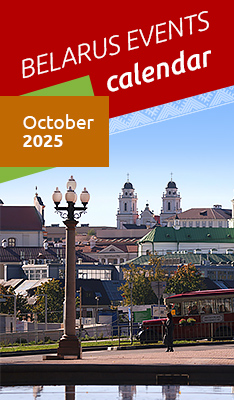




 print version
print version make home page
make home page add to bookmarks
add to bookmarks